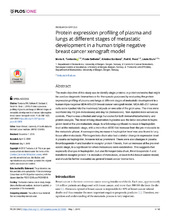Protein expression profiling of plasma and lungs at different stages of metastatic development in a human triple negative breast cancer xenograft model.
TVEITARÅS, MK; Selheim, Frode; Sortland, Kristina; Salvesen, Gerd Signe; Reed, Rolf K.; Stuhr, Linda Elin Birkhaug
Peer reviewed, Journal article
Published version

Åpne
Permanent lenke
https://hdl.handle.net/1956/22276Utgivelsesdato
2019-05-01Metadata
Vis full innførselSamlinger
Originalversjon
https://doi.org/10.1371/journal.pone.0215909Sammendrag
The main objective of this study was to identify single proteins or protein networks that might be used as diagnostic biomarkers or for therapeutic purposes by evaluating the protein expression profiling of plasma and lungs at different stages of metastatic development in a human triple negative MDA-MB-231 breast cancer xenograft model. MDA-MB-231 tumour cells were injected into the mammary fat pads on one side of the groin area. The mice were sacrificed day 19 (pre-metastases) and day 54 (metastases). Non-injected mice served as controls. Plasma was collected and lungs harvested for both immunohistochemistry and protein analysis. The most striking observation in plasma was the initial reduction in haptoglobin level at the pre-metastatic stage, to a following significant increase in haptoglobin level at the metastatic stage, with a more than 4000-fold increase from the pre-metastatic to the metastatic phase. A corresponding increase in haptoglobin level was also found in lung tissue after metastasis. Fibrinogen beta chain also had a similar change in expression level in plasma as haptoglobin, however not as prominent. There were also changes in plasma thrombospondin-4 and transferrin receptor protein 1 levels, from an increase at the pre-metastatic stage, to a significant fall when metastases were established. This suggests that especially changes in haptoglobin, but also fibrinogen beta chain, thrombospondin-4 and transferrin receptor protein 1 is indicative of metastasis, at least in this breast cancer model, and should be further evaluated as general breast cancer biomarkers.
